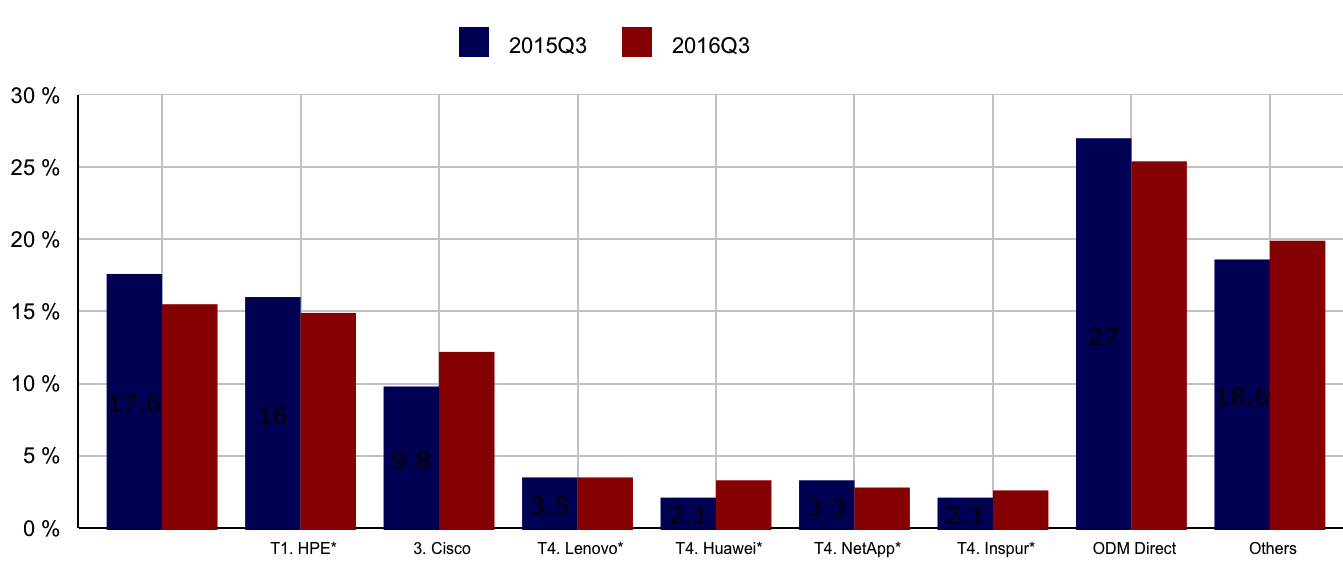WW Cloud IT Infrastructure Market Grew 8% Y/Y to $8.4 Billion in 4Q16 – IDC
1/ Dell EMC, 2/ HPE, 3/ Cisco, 4/ Lenovo, 5/ Huawei, 6/ NetApp 7/ Inspur
This is a Press Release edited by StorageNewsletter.com on January 16, 2017 at 2:48 pmAccording to the International Data Corporation‘s Worldwide Quarterly Cloud IT Infrastructure Tracker, vendor revenue from sales of infrastructure products (server, storage, and Ethernet switch) for cloud IT, including public and private cloud, grew by 8.1% year over year to $8.4 billion in 3Q16.
Ethernet switch continues to be the growth leader, as the market awaits new hyperscale datacenter builds to spur additional growth.
The overall share of cloud IT infrastructure sales climbed to 39.2% of all IT infrastructure spending in 3Q16, up from 34.7% a year ago. Revenue from infrastructure sales to private cloud grew by 8.2% to $3.3 billion, and to public cloud by 8.0% to $5.1 billion. In comparison, revenue in the traditional (non-cloud) IT infrastructure segment decreased 10.8% year over year in the third quarter. Private cloud infrastructure growth was led by Ethernet switch at 60.8% year-over-year growth, followed by storage at 9.0%, and server at 3.2%. Public cloud growth was also led by Ethernet switch at 46.2% year-over-year growth, followed by server at 6.8% storage at 3.0% year over year. In traditional IT deployments, server declined the most (12.9% year over year) with Ethernet switch and storage declining 1.6% and 8.6%, respectively.
“New cloud datacenters have begun to launch, but in the third quarter the effect on the cloud IT infrastructure market was minimal,” said Kuba Stolarski, research director for computing platforms, IDC. “As network upgrades continue to prop up cloud growth overall, the hyperscale cloud datacenters are coming and they will drive new server and storage deployments over the next few quarters. Recently, there has been renewed strength in emerging markets and among smaller cloud service providers. As OpenStack has become easier to implement and maintain by a growing population of capable system administrators, private cloud options are becoming more viable in an increasing set of use cases and with a wider set of deployment parameters.”
From a regional perspective, vendor revenue from cloud IT infrastructure sales grew fastest in Middle East and Africa at 36.7% year over year in 3Q16, followed by Japan at 29.9%, Latin America at 21.7%, Western Europe at 16.8%, AsiaPac (excluding Japan) at 11.9%, Canada at 5.3%, Central & Eastern Europe at 4.3%, and the United States at 2.9%.
Top 5 Vendor Groups, WW Cloud IT Infrastructure Vendor Revenue, 3Q16
(revenues are in $ million, excluding double counting of storage and servers)
WW Cloud IT Infrastructure Top 5 Cloud Vendors, 3Q16 vs 3Q15
(shares based on vendor revenue)
(Source: IDC Worldwide Quarterly Cloud IT Infrastructure Tracker, 3Q16)
Note: Dell Technologies combines Dell and EMC revenues
* Table note: Dell Technologies and Hewlett Packard Enterprise ranked number 1 in a statistical tie; Lenovo, Huawei, NetApp, and Inspur all ranked number 4 in 3Q16 in a statistical tie. IDC declares a statistical tie in the worldwide cloud IT infrastructure market when there is less than one% difference in the revenue share of two or more vendors.
Taxonomy notes:
IDC defines cloud services more formally through a checklist of key attributes that an offering must manifest to end users of the service. Public cloud services are shared among unrelated enterprises and consumers; open to a largely unrestricted universe of potential users; and designed for a market, not a single enterprise. The public cloud market includes variety of services designed to extend or, in some cases, replace IT infrastructure deployed in corporate datacenters. It also includes content services delivered by a group of suppliers IDC calls Value Added Content Providers (VACP). Private cloud services are shared within a single enterprise or an extended enterprise with restrictions on access and level of resource dedication and defined/controlled by the enterprise (and beyond the control available in public cloud offerings); can be onsite or offsite; and can be managed by a third-party or in-house staff. In private cloud that is managed by in-house staff, ‘vendors (cloud service providers)’ are equivalent to the IT departments/shared service departments within enterprises/groups. In this utilization model, where standardized services are jointly used within the enterprise/group, business departments, offices, and employees are the ‘service users.’













 Subscribe to our free daily newsletter
Subscribe to our free daily newsletter

